Bumble bee
| Bumblebee Temporal range: Eocene–Present |
|
|---|---|
 |
|
| Buff-tailed bumblebee (Bombus terrestris) | |
| Scientific classification | |
| Kingdom: | Animalia |
| Phylum: | Arthropoda |
| Class: | Insecta |
| Order: | Hymenoptera |
| Family: | Apidae |
| Tribe: | Bombini |
| Genus: |
Bombus Latreille, 1802 |
| Diversity | |
| > 250 species and subspecies | |
 |
|
| Natural distribution shown in red. Introductions to New Zealand, spread to Tasmania not shown |
|
A bumblebee (also written bumble bee) is a member of the genus Bombus, part of Apidae, one of the bee families. This genus is the only extant group in the tribe Bombini, though a few extinct related genera (e.g., Calyptapis) are known from fossils. Over 250 species of bumblebee are known. They are found primarily in higher altitudes or latitudes in the Northern Hemisphere, although they are also found in South America where a few lowland tropical species have been identified. European bumblebees have also been introduced to New Zealand and Tasmania. The brood parasitic or cuckoo bumblebees have sometimes been classified as a subgenus or genus, Psithyrus, but are now usually treated as members of Bombus.
Many bumblebees are social insects that form colonies with a single queen. The colonies are smaller than those of honeybees, growing to as few as 50 individuals in a nest. Female bumblebees can sting repeatedly, but generally ignore humans and other animals. Cuckoo bumblebees do not make nests; their queens aggressively invade the nests of other bumblebee species, kill the resident queens and then lay their own eggs, which are cared for by the resident workers.
Bumblebees have round bodies covered in soft hair (long branched setae) called pile, making them appear and feel fuzzy. They have aposematic (warning) coloration, often consisting of contrasting bands of colour, and different species of bumblebee in a region often resemble each other in mutually protective Müllerian mimicry. Harmless insects such as hoverflies often derive protection from resembling bumblebees, in Batesian mimicry, and may be confused with them. Nest-making bumblebees can be distinguished from similarly large, fuzzy cuckoo bees by the form of the female hind leg. In nesting bumblebees, it is modified to form a pollen basket, a bare shiny area surrounded by a fringe of hairs used to transport pollen, whereas in cuckoo bees, the hind leg is hairy all round, and pollen grains are wedged among the hairs for transport.
...
Wikipedia
